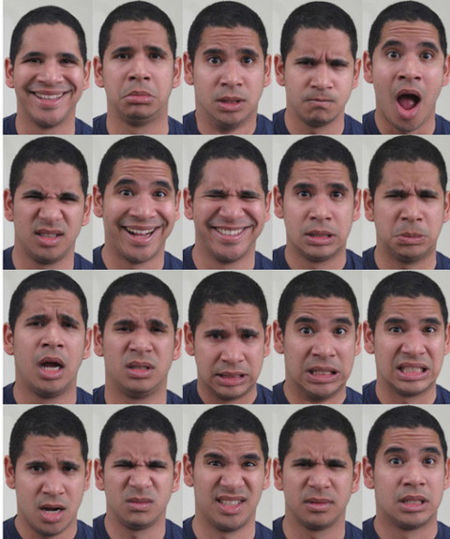双语:人类表情超丰富共有21种表情(图)
 人类的21种表情
人类的21种表情When you're feeling one of those combination emotions, like sadly angry or happily disgusted, it shows on your face in a unique way, a new study shows。
据LiveScience网站报道,当人们感受到上述复合情感时,例如悲愤或者又开心又讨厌,这些情感就会以一种特别的方式呈现在脸上。
In fact, there may be at least three times more recognizable human facial expressions than previously thought, the researchers said。
研究人员表示,事实上,可识别的人类面部表情的数量至少是之前所认为的三倍之多。
In a new study, researchers defined 21 facial expressions that we use to convey our emotions, and found that a computer model could tell them apart with a high degree of accuracy by looking for small changes in facial muscles。
在一项新研究中,研究人员定义了21种用于传递感情的面部表情,并发现,借助某种计算模型可以区分面部肌肉的微变化,从而准确分辨这些表情。
Among these facial expressions were the six, long-recognized basic emotions — happy, sad, fearful, angry, surprised and disgusted — but also 15 others, which were a combination of these basic feelings. For example, a person may show that they feel happily surprised, or angrily surprised, said the researchers, calling such feelings compound emotions。
这些表情中,最早为人所知的六种基本情感分别是,喜悦、悲伤、害怕、愤怒、和厌恶。另外15种则是这些基本情感的组合。例如,某人可能表现出惊喜,或者惊怒。研究人员将其统称为复合情感。
This extended library of facial expressions of emotions may be useful in studying human brain and social communication, as well as in the design of computer systems that can communicate with humans, researchers said in their study published today (March 31) in the journal Proceedings of the National Academy of Sciences。
3月31日发表在美国国家科学院院刊上的报告显示,对情感投射的面部表情进行这样的词汇扩充,有助于人脑和社会交流的研究工作、以及与人类交流的计算机系统的设计工作。
"We've gone beyond facial expressions for simple emotions like 'happy' or 'sad.' We found a strong consistency in how people move their facial muscles to express 21 categories of emotions," said study researcher Aleix Martinez, a cognitive scientist and associate professor of electrical and computer engineering at The Ohio State University. "That tells us that these 21 emotions are expressed in the same way by nearly everyone, at least in our culture."
“人类的面部表情早就不局限于表达像喜悦或者悲伤这样的简单感情了。我们发现,人们在运用面部肌肉表达21种表情时具有高度的一致性。”研究者亚历克斯·马丁内斯介绍说。他是俄亥俄州立大学电子与计算工程专业的副教授,也是一位认知学家。他说:“研究结果告诉我们,每个人在表达这21种情感时几乎使用同一种方式,至少在我们的文化中是这样的。”
Historically, scientists and philosophers have focused their studies on six basic emotions, but deciphering a person's brain functioning with only six categories is like painting a portrait with only primary colors, Martinez said in a statement。
历史上,科学家和哲学家们都将研究重点放在六种基本情感上。但仅仅利用这六种类型就想弄清楚人脑功能是不可能的,就好比只用基本色绘制肖像画。马丁内斯评论说。
In the study, the researchers took about 5,000 photographs of 230 college students who were asked to make faces in response to verbal cues such as, "You just got some great, unexpected news" (happily surprised) or "You smell a bad odor" (disgusted)。
在他们的研究中,研究者选择了230位大学生,要求他们对所提供的语言提示给出面部反应,然后将他们的反应通过拍照记录下来,总共拍了大约5000张照片。提供的语言提示类似于“你刚刚得知了出人意料的好消息”(惊喜),或者“你闻到了怪味”(厌恶)。
To determine which expressions were unique enough to be consistently distinguished from others, the researchers analyzed the photographs with a computer program called the Facial Action Coding System (FACS). Popularized by psychologists in the 1970s, FACS breaks a facial expression down into its elements, such as raised eyebrows or wrinkled nose, and analyzes the underlying muscle movements that are used to create that expression。
为了确定哪些表情足够特别,能区分于其它表情,研究人员借助名为面部表情编码系统(FACS)的计算机程序进行了数据分析。这种程序在七十年代被心理学家们广泛应用于研究中。它将面部表情分解成小组分,例如挑眉、或者皱鼻,然后分析其中暗含的肌肉运动。正是这些肌肉运动才导致了这种表情。
The FACS analysis revealed that the 21 expressions used a unique combination of muscles that was different from all other expressions. A computational model of face perception identified the six basic expressions with 96.9 percent accuracy, and the 15 compound expressions with 76.9 percent accuracy。
FACS分析显示,这21种表情涉及到的肌肉运动组合彼此不同,可以作为区分依据。一种面部感知计算模型可以区分这些表情,在确定六种基本情感时准确率高达96.9%,15种复合表情的准确率达到了76.9%。
Some expressions were more consistently recognizable than others, the researchers said. For example, 99 percent of the time study participants used the same muscle movements to express happy, whereas for compound emotions, such as happily surprised, the participants expressed it the same way 93 percent of the time。
研究人员说,一些表情更容易区分。例如,99%的研究参与者使用同样的肌肉运动表达喜悦,但对于复合情感,如惊喜,他们的一致性只有93%。
Although the collection of emotional expressions would be of most interest for basic research in cognition, researchers said that it may be also useful for understanding whether perception of compound emotions is altered in psychiatric disorders such as schizophrenia, orsocial impairments such as autism。
收集情感表达虽然是认知学基础研究中很有趣的部分,但研究人员表示,它对理解复合情感的感知在精神疾病(如精神分裂),或者社交障碍(如自闭症)中是否发生变化也同样有用。
- 可爱宝宝“恶魔”表情图集(组图)2013-04-03 15:25
- 明星宝宝模仿爸妈 谁的表情更搞怪(组图)2013-03-13 15:08
- 双语:喜怒哀乐“表情”英文集萃(图)2010-07-17 15:02
- 爆笑:西方大学生一天的囧表情(组图)2010-06-28 15:37
- 双语:解读懂东西方人的脸部表情(图)2009-08-21 14:54
- 六大表情教你察言观色识别谎言:Fear2009-03-25 14:01
- 老外常用的网络缩写语:特殊用语和表情2008-12-19 13:54

